The Smart #3 marks a significant step in the evolution of electric mobility. Designed as a stylish compact SUV coupe, it brings together performance, technology, and sustainability under the renowned Smart and Mercedes-Benz partnership. Building on the success of the Smart #1, the Smart #3 offers a larger body, sportier design, and superior range, making it a top contender in the European and Asian EV markets.
Smart #3 Overview
The Smart #3 is an all-electric crossover SUV developed jointly by Smart Automobile, a venture between Mercedes-Benz Group and Geely Holding. Officially revealed in 2023, the model combines German engineering precision with Chinese manufacturing efficiency.
It is built on Geely’s Sustainable Experience Architecture (SEA) platform, the same foundation used for models like the Volvo EX30 and Zeekr X. The showcases premium quality, aerodynamic design, and impressive driving dynamics.
Design and Exterior Features
The embodies a sleek, coupe-inspired design that emphasizes sportiness and elegance. Highlights include:
- Aerodynamic silhouette with a drag coefficient of just 0.27 Cd
- LED matrix headlights and a panoramic halo roof
- Flush door handles and 20-inch alloy wheels on higher trims
- Distinctive two-tone body colors for a luxury appearance
The exterior design, crafted by Mercedes-Benz’s global design team, reflects a youthful and modern vibe while maintaining aerodynamic efficiency.
Interior and Comfort
Inside, the Smart #3 focuses on comfort, connectivity, and minimalism. It features:
- A 12.8-inch central infotainment touchscreen
- 9.2-inch digital driver display
- Optional head-up display (HUD)
- 64-color ambient lighting
- Premium materials including vegan leather upholstery
- Beats Audio sound system for immersive sound
The Smart #3 also offers ample legroom and a 350-liter boot capacity, making it practical for small families or city commuting.
Performance and Powertrain
The Smart #3 comes in multiple versions: Pro+, Premium, Brabus, and Launch Edition.
Each offers distinct performance configurations.
| Variant | Power Output | 0–100 km/h | Top Speed | Drive Type |
|---|---|---|---|---|
| Pro+ | 200 kW (272 hp) | 5.8 sec | 180 km/h | RWD |
| Premium | 200 kW (272 hp) | 5.8 sec | 180 km/h | RWD |
| Brabus | 315 kW (428 hp) | 3.7 sec | 200 km/h | AWD |
The Brabus edition is the most powerful Smart ever made, featuring dual motors for all-wheel drive and lightning-fast acceleration.
Battery, Range, and Charging
The Smart #3 uses a 66 kWh lithium-ion battery pack, providing excellent efficiency.
| Variant | Battery Capacity | WLTP Range | DC Fast Charge (10–80%) | AC Charge (11 kW) |
|---|---|---|---|---|
| Pro+/Premium | 66 kWh | 435–455 km | 30 mins | 6.5 hrs |
| Brabus | 66 kWh | 415 km | 30 mins | 6.5 hrs |
⚡ Range Calculation Example
If you drive 50 km daily, here’s how long one full charge lasts: Battery Range=450 km (average)Daily Distance=50 km/dayDays per Full Charge=450/50=9 days\text{Battery Range} = 450 \text{ km (average)} \text{Daily Distance} = 50 \text{ km/day} \text{Days per Full Charge} = 450 / 50 = 9 \text{ days}Battery Range=450 km (average)Daily Distance=50 km/dayDays per Full Charge=450/50=9 days
So, one full charge lasts around 9 days for an average city commuter.
🔋 Charging Cost Calculation (Example)
If your local electricity rate is $0.20 per kWh,
then the cost for a full charge is: Cost=66 kWh×$0.20=$13.20\text{Cost} = 66 \text{ kWh} \times \$0.20 = \$13.20Cost=66 kWh×$0.20=$13.20
At 450 km per charge, your running cost per km is: $13.20/450=$0.029/km\$13.20 / 450 = \$0.029/km$13.20/450=$0.029/km
That’s roughly 3 cents per kilometer, significantly cheaper than fuel vehicles.
Technology and Safety
The Smart #3 includes state-of-the-art driver-assistance systems (ADAS) such as:
- Adaptive Cruise Control (ACC)
- Lane Keeping Assist (LKA)
- Traffic Sign Recognition (TSR)
- Autonomous Emergency Braking (AEB)
- Blind Spot Detection (BSD)
- 360-degree camera system
Smart #3 also supports over-the-air (OTA) updates, keeping software and features up to date without visiting a dealership.
Infotainment and Connectivity
The vehicle is powered by a Qualcomm Snapdragon cockpit platform, ensuring ultra-fast processing for the infotainment system.
It includes:
- Voice Assistant (“Hi Smart”)
- Smartphone integration (Apple CarPlay & Android Auto)
- Navigation with real-time traffic
- Wireless charging pad
- OTA system updates
Price and Market Availability
As of 2025, Smart #3 pricing in Europe starts around:
- Pro+ – €38,000
- Premium – €42,000
- Brabus – €48,000
In Asian markets like China, prices are slightly lower due to local production efficiencies, starting near ¥230,000 RMB.
Comparison: Smart #3 vs Smart #1
| Feature | Smart #1 | Smart #3 |
|---|---|---|
| Length | 4,270 mm | 4,440 mm |
| Range | Up to 440 km | Up to 455 km |
| 0–100 km/h | 6.7 sec | 5.8 sec |
| Interior Space | Compact | Larger |
| Body Style | Hatchback SUV | Coupe SUV |
The Smart #3 delivers improved performance, aerodynamics, and cabin space, making it more suited for small families and long drives.
Environmental Benefits
The Smart #3 is a zero-emission vehicle (ZEV), contributing to cleaner cities and sustainable transport. With its efficient battery system, it emits 0 g/km of CO₂ during operation.
Over a 10-year period, a Smart #3 can reduce over 25 tons of CO₂ compared to a gasoline vehicle, assuming 15,000 km annual usage.
Pros and Cons of Smart #3
✅ Pros
- Excellent range and fast charging
- Premium design and interior
- Low running cost
- High safety ratings
- Smooth, quiet performance
❌ Cons
- Limited charging infrastructure in some regions
- Slightly higher upfront price
- Smaller cargo space than larger SUVs
Conclusion
The Smart #3 is an impressive leap for the Smart brand, blending electric efficiency, luxury comfort, and urban practicality. Whether for city driving or weekend road trips, it offers an enjoyable, eco-friendly, and cost-effective experience.

